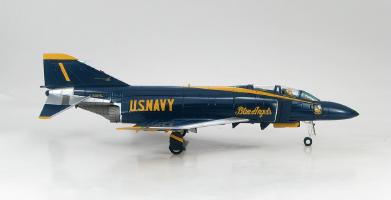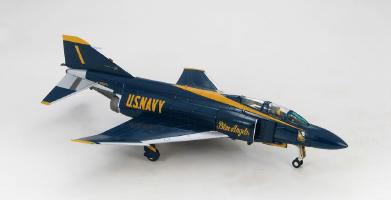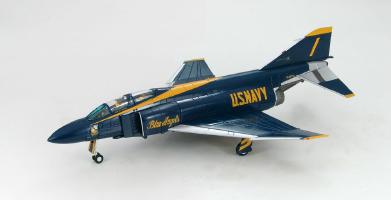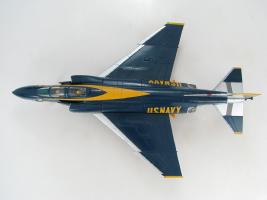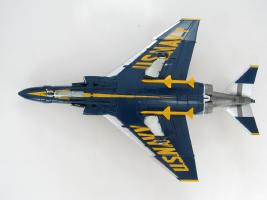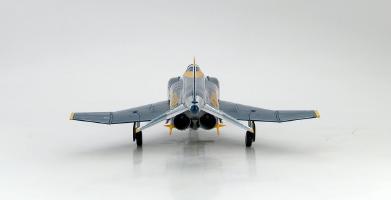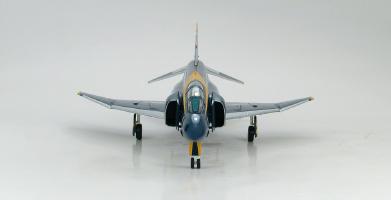Hobby Master Archive
Air Power Jets 1/72
F-4
McDonnell Douglas F-4J Phantom II USN Blue Angels
Hobby Master 1/72 Air Power Series HA1903 McDonnell-Douglas F- 4J Phantom II USN “Blue Angels”
True 1/72 scale Professionally painted Great attention to detail All markings are Tampoed (pad applied) Option to display the model on a stand that is provided Model can be shown with the landing gear in the down or up positions Canopy can be displayed open or closed Comes with pilot figure Extremely heavy metal with a minimum of plastic Highly collectable
The F-4 “Phabulous Phantom” first flew in 1958 and was finally retired from US service in 1996. At this time 8 other nations still flew the F-4 Phantom II. Over the years the F-4 held numerous records for altitude, rate of climb, speed and others such as the Demonstration Teams. From 1958 to 1979 there were a total of 5,195 F-4s built in all variants. Each aircraft had 54,197 feet of wiring and 643,000 fasteners holding it all together. together.
The last version of the Phantom II produced for the USN and USMC was the F- 4J. Between 1966 and 1972 there were 522 F-4Js built. The USN received their first F-4Js in 1966 and the USMC in 1967. The F-4J had the distinction of scoring the only USMC air-to-air combat victory in Vietnam and it also was the last US operational aircraft in South East Asia. In mid 1970 the F-4 Phantom II was being replaced by the new and improved F-14 Tomcat.
By the late 1960s the US military was deeply involved in Vietnam and every aircraft was considered necessary for the war. The USAF Thunderbirds Flight Demonstration Team was using the F-4 Phantom and the USN cried foul. They argued that the F-4 Phantom II was originally built for the USN and they too should have this aircraft for their Blue Angels. In 1968 seven modified Phantoms were allocated to the Blue Angels but in 1974 after three fatalities the F-4 was traded for the fuel efficient A-4.
In 1950 the Blue Angels and their F9F-2s joined the Korean War as part of USS Princeton’s Fighter Squadron VF-191 “Satan’s Kitten’s”. In 1951 the demonstration team resumed flying using the faster F9F-5 Panther. In 1954 the team acquired the Grumman F9F-8 Cougar, in 1957 the F11F-1 Tiger, the F-4J Phantom II in 1969 and in 1974 the Blue Angels began flying the A-4F Skyhawk. In their 40th anniversary year the F/A-18 Hornet became the new aircraft. By 2006 the Blue Angels had thrilled over 427 million spectators world wide.
Specification for the F-4J Engines: 2 X General Electric J79-GE-8B/8C/10 turbojets, 11,870 lb.s.t dry, 17,900 lb.s.t. with afterburner.
Performance Maximum speed: 1,584 mph at 48,000 ft. (Mach 2.4), 875 mph at sea level (Mach 1.15). Initial climb rate: 41,250 fpm. Service ceiling: 70,000 ft. Combat ceiling: 54,700 ft. Combat range: 596 miles, maximum range 1,956 miles with maximum external fuel.
Weights 30,770 lbs empty. 46,833 lbs gross. 41,399 lbs combat weight, Dimensions Wingspan: 38 ft. 5 in. Wing area: 530 square ft. Length: 58 ft. 3.75 in. Height: 16 ft. 3 in.
Fuel Maximum internal fuel: in fuselage tanks 1,347 US gal. Internal wing tanks: 630 gal. Maximum external fuel: 3,317 US gal. 600 US gal in a centerline tank, 370 US gal in each of two tanks that could be carried underneath the outer under wing pylons.
Armament 4 X AIM-7 Sparrow semi-active radar homing air-to-air missiles in semi- recessed slots in the fuselage belly. 2 X to 4 AIM-9 Sidewinder infra-red homing air-to-air missiles carried under the wings on the inboard pylons. Maximum offensive load of up to 16,000 lbs carried on the centerline and 4 under wing hard points.
| Added to archive | 2015-11-19 |
| Last modified | 2015-11-19 |
| Leaflet | 2008-06-01 June 2008 |
